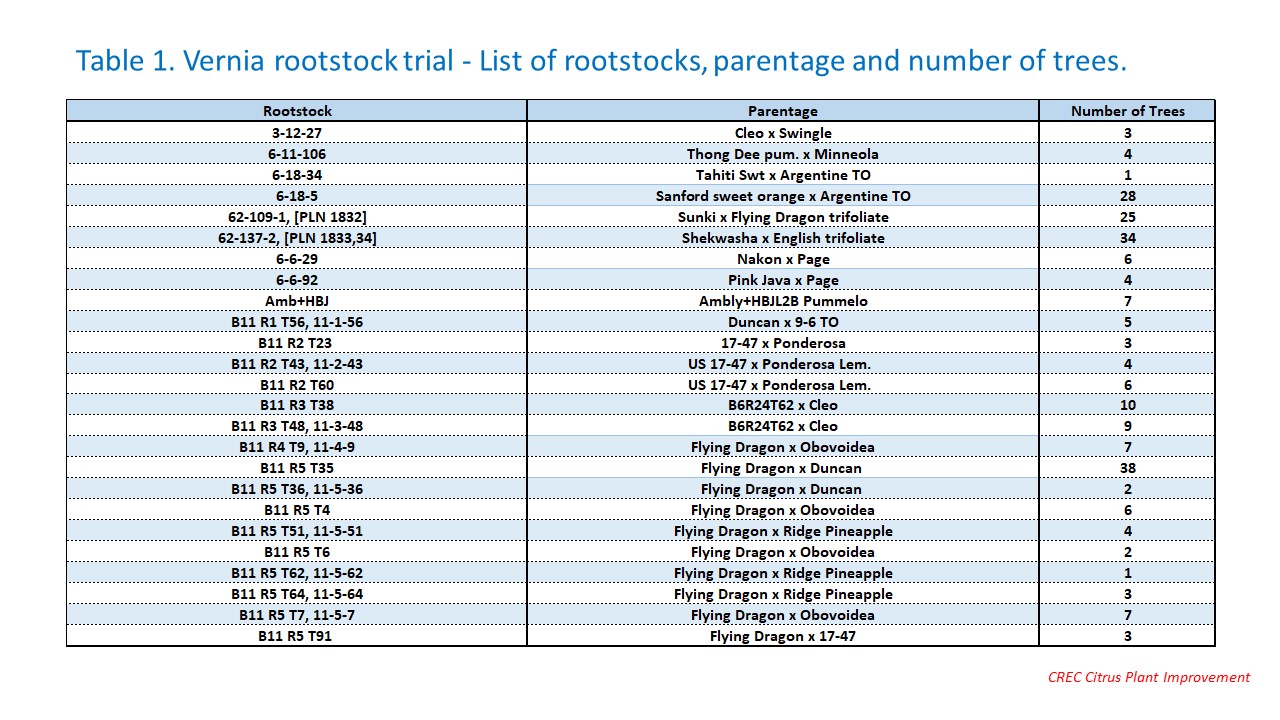Vernia Rootstock Trial, LaBelle
Dr. Bill Castle – Dr. Fred Gmitter – Dr. Jude Grosser
November 26, 2021 – revised
October 19, 2021 - updated
April 21, 2021 - updated
November 18, 2020 - updated
December 10, 2019 - updated
September 6, 2019 - posted
CREC Citrus Plant Improvement
Vernia Rootstock Trial, LaBelle - Description
Vernia sweet orange is the scion in this cooperator trial planted mostly in March 2010 in a flatwoods grove located south of LaBelle near Felda and west of Highway 29. The site is described by the cooperator as one of their better ones based on the high level of performance of the previous citrus planted on the site. The trial consists of trees on 76 rootstocks among which are the ES series from Spain, the C-series from California and various sexual and somatic hybrids produced by the CREC plant breeding team. Virtually all the rootstocks are those included in several other trials; thus, this trial is one of a network of trials intended to evaluate the rootstocks at multiple sites with different scions.
Vernia Rootstock Trial, LaBelle - Summary
- Location: LaBelle – Felda, Hendry County
- Scion: Vernia
- Rootstocks: 76
- Date Planted: March 2010
- Design: Randomized complete-block with 1-7 replications planted in East-West rows
- Plot size: mostly 2-8 trees
- Spacing: 7.5 x 22 ft. = 264 trees/acre.
- Data (Although trees on 76 rootstocks were planted originally, there are some graphical results with only 48 rootstocks. That difference is the result of attrition especially among the smaller plots [1-3 trees] and to other factors like hurricanes or poor to no cropping.)
- 2013/14: Yield.
- 2014/15: Yield, HLB rating, juice quality, PS/acre.
- 2017/18: Yield, tree size, HLB rating,
- 2018/19: Yield, HLB rating, juice quality, PS/acre.
- 2019/20: Yield, HLB rating.
- 2020/21: Yield, HLB rating, juice quality, PS/acre.
- 2021/22: Tree height
- 6-year cumulative yield.
- Trial status: INACTIVE
Vernia Rootstock Trial, LaBelle – Interpretive Summary [as of March 2021].
This trial was planted in March 2010 and was comprised originally of trees on 76 rootstocks. What follows is a summary of those trees on about 48 rootstocks that had sufficient replication and growth and cropping to merit collecting data.
General. Most striking were not the differences among rootstocks, but the overall lower juice quality presumably because of HLB. Typically, Brix values were about 8-11 with some variability because of the time of year when fruit samples were harvested; acid was about 0.5; PS/box values were in the 4-6 range.
Growth. When the trees were about 7 years old, they had grown to about 5-8 ft. [Fig. 10]. Most trees were 6 ft or taller and only a few rootstocks were among the smallest.
HLB. Most trees had visible symptoms of HLB. Among those least affected were trees on White 1, C-22, C-146, 11-5-62, 11-5-4, 11-5-64, and 21-9-6.
PS/acre. Values were generally low, but among the rootstocks, relatively high values in a hypothetical calculation of 2018-19 [Fig. 15] and 2020-21 [Fig. 27] data were trees on ES-1, C-146, B21R4T26 and 62-137-2. The rootstock story changed somewhat across cumulative PS [Table 2].
Cumulative yield. One of the better measures of tree performance is cumulative yield, in this case, over 6 seasons [Fig. 33]. The top performers were the trees on 11-5-4, 62-137-2, 21-3-24, ES-1, C-146, C-57 and C-22.
Rootstocks. Various factors, some mentioned previously, affected the trial outcomes in such a manner as to reduce the trial's precision. As a result, sharp or clear differences among rootstocks were not as evident as might otherwise occur. However, the trees on some rootstocks were consistently among the top performers and are worthy of further evaluation. Taking into consideration HLB ratings, PS/box and acre and cumulative yield, promising rootstocks were:
- 11-5-62
- 11-5-4
- C-22
- ES-1
- C-146

.jpg)

![Table 1 [cont’d]. Vernia rootstock trial - List of rootstocks, parentage and number of trees.](/media/crecifasufledu/citrus-research/images/rootstock-trials/labelle-vernia/trial14_table1b.JPG)
![Table 1 [cont’d]. Vernia rootstock trial - List of rootstocks, parentage and number of trees.](/media/crecifasufledu/citrus-research/images/rootstock-trials/labelle-vernia/trial14_table1c.JPG)